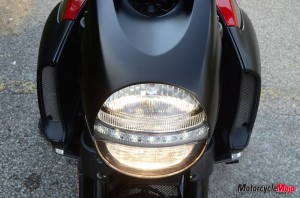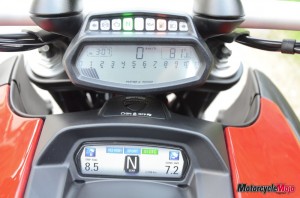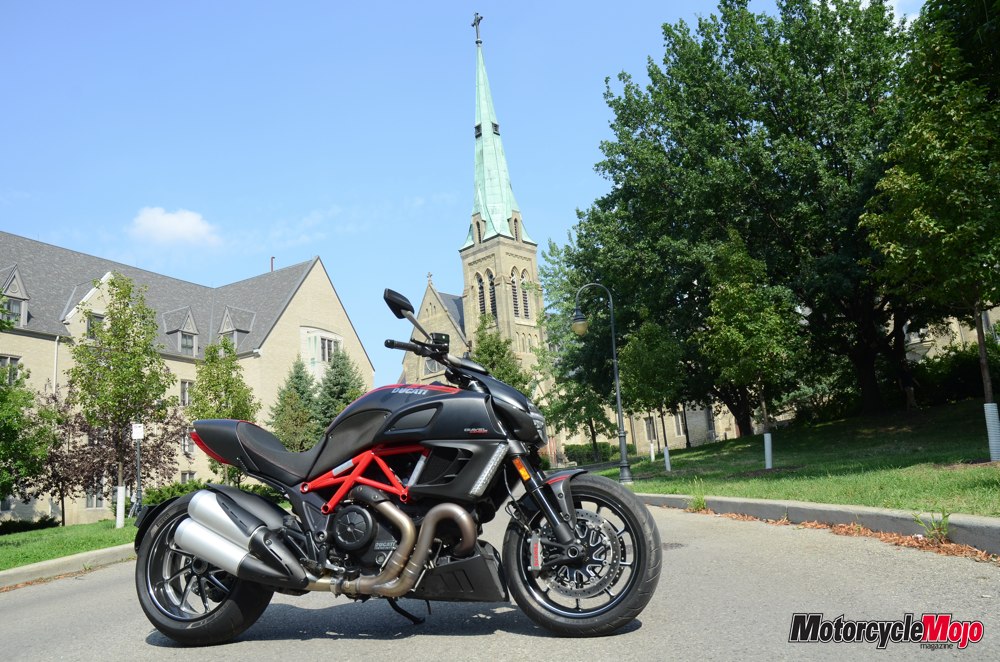It takes a big pair of palle to mass-produce a motorcycle like the Diavel. Easily one of the most ostentatious motorcycles Ducati has ever built, the company’s hyperbole claims that the exotic motorcycle was conceived when its designers asked “what if?” and they began work on their dream machine, a lower and longer incarnation of Ducati’s mainstay sportbikes. One look at the Diavel will cause you to question whether that idyllic dream wasn’t really an opium-induced nightmare. Even those within Ducati’s ranks were initially shocked by the machine. When the prototype of the Diavel was revealed for the first time to a group of Ducati engineers, one apparently blurted out in Bolognese, “Ignurànt comm’ al diavel!” The subtitles, had they been available, would have read, “Evil, just like the devil!”
It would be easy to understate the importance of the Diavel to Ducati. When you consider the long history of radical designs that have suffered an inglorious death on the showroom floor, it’s possible to appreciate the monumental risk Ducati took with this unorthodox machine. One Ducati employee admitted to me that the Diavel was actually a Hail Mary pass; had the bike not sold in numbers, there was a chance that it could have broken the company financially. Fortunately for Ducati, the Diavel has become a success, and incredibly – according to my source – it’s actually the second best–selling model in their range.

First impressions of the Diavel are monopolized by its extroverted design, clearly intended to turn heads. Having parked the Ducati ona busy Toronto street, I stood back and observed pedestrian reaction to its imposing bulk. A surprising number of people stopped dead in their tracks, some stood slack-jawed as they tried to make sense of the bizarre-looking lump with a rear tire big enough to eat their young. Of course, any fool could see that it was a motorcycle, but this thing was unabashedly unlike anything they were familiar with.
The Diavel’s unmistakable profile is defined by its dominating stance, which Ducati describes as “confidence that borders on superiority.” I think it’s purely demonic. Two large lateral radiators and aluminum air-intake scoops mounted on each side of the fuel tank add brawn to the bike’s shoulders. Its physique then tapers down through the engine to its belly pan, which is more than just an aesthetic accoutrement; used to conceal an oil cooler along with the bike’s battery and some of its electrical components, you don’t want to ever risk bouncing it off a curb.
The fat handlebar, which tapers down at the grips, is a bit of a reach. That’s great if you’re tall or have freakishly long arms, but alternate pilot Roger Parsons, who is barely tall enough to reach the peanut butter on the top shelf, looked like he was bending over a pool table when riding the Diavel. The handlebar is fitted with Ducati’s most minimalistic switchgear. A combination starter and kill switch uses what Ducati calls a “weapons-like trigger catch” that slides down to cover the starter button as it activates the kill switch. The turn signal cancel button also performs double duty as a scroll and select switch to change the bike’s riding modes, as switches above and below it are used to navigate the TFT display on the fuel tank.
 The Diavel’s instrumentation is another attention grabber. The upper LCD provides mission-critical information such as speed, rpm, and coolant temperature. The lower, full-colour Thin Film Transistor (TFT) display embedded into the fuel tank displays the bike’s current riding mode and traction control settings, a gear indicator, and readings from the fuel mileage computer. Providing the bike is stationary, the TFT also acts as the interface for an options menu that allows you to customize numerous settings.
The Diavel’s instrumentation is another attention grabber. The upper LCD provides mission-critical information such as speed, rpm, and coolant temperature. The lower, full-colour Thin Film Transistor (TFT) display embedded into the fuel tank displays the bike’s current riding mode and traction control settings, a gear indicator, and readings from the fuel mileage computer. Providing the bike is stationary, the TFT also acts as the interface for an options menu that allows you to customize numerous settings.
Another electronic convenience is the Diavel’s key fob, which enables the bike to be started without actually using a key. The fob does house a traditional flip-key, but it’s used to unlock the seat and fuel-tank cap. The bike also features an electronic steering lock, which is actuated by turning the handlebar to full lock and pressing the ignition-off button.
The rider’s seat is wide and relatively comfortable; at 770 mm (30.3 in.), the Diavel has one of the lowest seat heights in Ducati’s range, and it did cause my long legs to feel a little cramped during long rides. Far more interesting than the rider’s accommodations is the pillion perch, which on the Carbon model is concealed by a svelte, easily removable cover. With the shroud removed, passenger seating literally unfolds from the machine; slender footpegs swing elegantly down from the rear sub-frame as a retractable grab bar slides out from underneath the seat.
At the heart of the Diavel is the Testastretta 11°, a variant of the Testastretta Evoluzione engine used in the Ducati 1198. The superbike engine was tuned to combine rideability with performance by revising its intake and exhaust ports and modifying its radical cam timing. Reduced from 41 degrees to 11, the Testastretta 11° has a milder valve overlap angle to create a more practical torque curve during lower rpm operation. If you’re wondering about overlap angle, it’s a measurement of the crankshaft’s rotation, during which both the intake and exhaust valves are open.
Typical of a Ducati, the powerful 1198 cc L-twin engine cranks so slowly during starting that I was convinced the battery was practically dead. Equally familiar was the sound that greeted me when it erupted into life. The tenor of a whirring valve train mixed nicely with the bass of its massive 58 mm headers and 2-1-2 exhaust. Give it some gas, and a Diavel rider will swear that he’s being chased by a pride of ravenous lions. Like the satanic messages that paranoid parents once suspected were hidden in the vinyl albums their kids were listening to, something within the deep burble of the Diavel’s exhaust kept subconsciously persuading me to ride it harder and faster.
Riding a Diavel hard is something that is too easily done. Throttle response was crisp; a hard twist of the grip would immediately launch the bike forward with laugh-inducing thrust. And although I always kept the bike in its most aggressive setting, there was always the option to electronically tailor the engine’s performance to varying riding conditions. Not just some smoke-and-mirrors marketing gimmick, the Diavel’s adjustable riding modes actually have a profound effect on the bike’s performance. By interfacing with the engine’s ride-by-wire throttle system, the ECU allows riders to not only adjust the engine’s power delivery, but also the amount of allowable rear wheel spin through the eight-level, race-derived Ducati Traction Control system (DTC).
The Sport Mode is a fire-at-will setting that enables full-on throttle response at full power, which for the Testastretta 11° is claimed to be 162 hp. At the same time, it sets the DTC to level 3 performance (the lower the number, the less traction control you get), which puts riders closer to the tire’s traction limit. While you can’t dispute that the Diavel has a lot of power at the rear wheel, more satisfying is the bike’s grunt, a respectable 127.5 N-m (94 ft-lb) of torque that makes the Diavel a hard charger in every situation.
Touring Mode also allows the full 162 hp; however, the ECU mutes throttle response for a more rider-friendly power delivery, as the DTC’s intervention increases to level 4. The safe-as-houses Urban Mode precludes the dangers of riding in a congested city, limiting the engine to 100 hp and bumping the DTC up to level 5. Although each riding mode has a default traction and power setting, both elements can be adjusted and then saved to create your own personalized version of each mode.
The effort required to compress the clutch lever to the handlebar will reduce even a steroid-enriched bodybuilder to tears if he is caught in an afternoon rush hour. Outside of heavy traffic, the clutch action felt smooth, in part because it uses a self-servo mechanism that presses the clutch plates together when under drive from the engine. The same mechanism works as a race-like slipper clutch when the drive force is reversed, as it would be during aggressive downshifting. The Diavel’s six-speed gearbox worked flawlessly and is made from high-strength materials to deal with the extra grip generated by its 240-section rear tire.
Everything about the Diavel’s appearance suggested that it would handle like a heavily laden wheelbarrow with a flat tire. Its obscenely-sized rear bun alone would certainly relegate the bike to one-trick pony status – great in a straight-line drag, but heaven help you if there was a bend to contend with. I couldn’t have been more wrong. The bike’s superb chassis allowed the Diavel to competently carve through turns. Admittedly, it still isn’t an appropriate choice for track use, as its lean angle is restricted by a limited ground clearance, but that doesn’t mean Diavel owners should shy from throwing their bikes through a corner.
A fully adjustable 50 mm Marzocchi fork and linked Sachs rear shock, horizontally slung under the chassis, contributed to the Diavel’s decent road manners. Further aiding handling was the Pirelli Diablo Rosso II tires, which were specifically engineered for the bike. The sport-oriented profile of the 120/70-17 front and 240/45-17 rear made it easy to tip the bike into a lean.
Stopping a Diavel is almost as mindless as getting one to go fast. The brakes actually performed so well that they were never on my radar. Highlighted by a pair of Brembo Monobloc calipers at the front that are actuated by an integral master cylinder, all it took was a gentle squeeze of the lever to shave off as much speed as needed. And if you’re caught napping, the bike is equipped with the newest, most compact Bosch-Brembo ABS system. The ABS’s actuation wasn’t as transparent as a race-oriented system, but it worked well to keep the chassis in line without excessively hammering my hand or foot during all-out braking manoeuvres.
Our long-term Carbon is an upscale model in the Diavel range. Available in a stealthy all-black finish, or with glossy red highlights, the Carbon is defined by its use of milled aluminum parts and the carbon-fibre components from which the bike gets its name. The lightweight composite material used
for the fuel tank surround, the pillion seat cover and the front fender helps reduce the machine’s overall dry weight by 3 kg from the base Diavel’s claimed 210 kg (463 lb.) mass.
Carbon owners can also boast that their Marzocchi forks use a low-friction, diamond-like carbon (DLC) finish and that their bikes are fitted with lighter Marchesini wheels, which have been milled to expose their aluminum construction. Those after something even more exclusive will want the Diavel AMG, a special edition that will ensure your Diavel will stand out from the others on your block.
If your pockets aren’t deep enough for the Carbon or AMG, don’t fret. Inability to afford their weight savings is hardly a deal breaker when you consider one of the more surprising aspects of the Diavel, which it is already a light motorcycle to begin with. Sure, the Diavel looks like it weighs more than a fridge full of cinder blocks, but Ducati has performed a masterful deception by building a hefty-looking motorcycle that in reality is marginally heavier than a high-end sportbike.
At $21,395 ($20,995 in black), the Diavel Carbon is not an inexpensive motorcycle. It’s a $2,400 premium over a base Diavel, but a bargain next to the $5,600 more expensive AMG. Given how hard we consistently rode the bike, its average fuel economy of 5.58 L/100 km was a pleasant surprise. Combined with Ducati’s major service intervals, which have been increased to 24,000 km, lower operating costs help to soften the Carbon’s sticker price.
It would be convenient, but unfair, to peg the Diavel as a power cruiser. It’s too light and nimble to be slotted into a cruiser sub-genre. And it’s too long and bulky (in appearance) to be considered a naked bike. Lacking the handling prowess of a sportbike, there’s really nothing else on the market that the Diavel can be compared to. However, it does have a simple bottom line: If just the sight of a Diavel is enough to get your wheels spinning, it’s the right bike for you, because it’s truly as much fun as it looks. After two months of testing, I was clearly possessed by the Diavel and felt as though I had been exorcised when we finally parted company. Ducati deserves accolades for straying so far off their beaten path, even if the Diavel’s success has obviously been the result of a nefariously Faustian bargain.
2011 Ducati Diavel Carbon Spec Chart
| MODEL | 2011 Ducati Diavel Carbon |
| List Price | $21,395 (Red and Matt Carbon) |
| Warranty | 2 years |
| Engine Type | Liquid-cooled, DOHC, 8-valve, 90-degree L-twin |
| Displacement | 1198 cc |
| Power (claimed) | 119kW (162 hp) at 9500 rpm |
| Torque (claimed) | 127.5 N-m (94 ft-lb) at 8000 rpm |
| Bore and Stroke | 106 x 67.9 mm |
| Compression Ratio | 11.5:1 |
| Fuel Delivery | Mitsubishi electronic fuel injection with Mikuni elliptical throttle bodies |
| Transmission | 6-speed |
| Final Drive Type | Chain |
| Front Suspension | 50 mm inverted Marzocchi fork, DLC coated, with adjustable preload, compression and rebound damping |
| Rear Suspension | Sachs linked monoshock with adjustable preload, compression and rebound damping |
| Wheel Travel | 120 mm (4.7 in.) front; 120 mm (4.7 in.) rear |
| Brakes | Front: Two 320 mm semi-floating discs with radially mounted, Monobloc Brembo four-piston calipersRear: One 265 mm disc with two-piston caliper |
| Wheelbase | 1590 mm (62.6 in.) |
| Rake and Trail | 28 degrees/130 mm |
| Tires | 120/70-17 front; 240/45-17 rear |
| Weight | 207 kg (456 lb.) |
| Seat Height | 770 mm (30.3 in.) |
| Fuel Capacity | 17 L |
| Fuel Economy (observed) | 5.58 L/100 km (50.6 mpg) |
| Fuel Range (estimated) | 305 km |














































